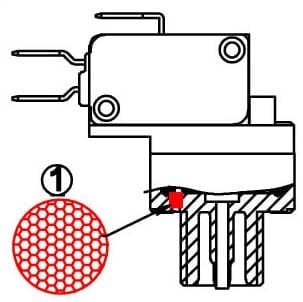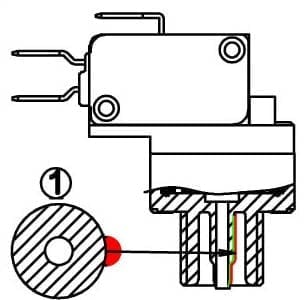Differences between air switches and pressure switches
A PRESSURE SWITCH IS A PRESSURE CONTROL DEVICE
Pressure switches are used to control the pressure of a medium and operate an electrical device. When pressure rises to the set point value, they switch off the equipment or switch on an alarm. Fluid they control can be air or water. There is no barometric or ambient temperature compensation in pressure switches.
There are 3 types of pressure switches:
- Positive pressure switches,
- Negative (vacuum) pressure switches,
- Differential pressure switches (pressure difference between 2 pressure
ports)
There are two types of pressure switches electrical action:
- Pressure control: they switch off when the set point is reached and when pressure goes below the pressure hysteresis value (also named differential), they automatically switch on again.
- Pressure high limit, with manual reset: they switch off when the set point is reached and do no automatically switch on when pressure decreases. To restart, it is necessary to manually actuate the reset button
Unique features of pressure switches of this catalogue:
1. Wide range of pressure connection systems:
- Center spout for 1/8” and 1/16” OD soft tubing with 1/4”NPT mounting screw (fits also directly on 1/4” pipes threads)
- Center spout for 1/8” and 1/16” OD soft tubing with 9/16-18” mounting screw, 2 flats D slot
- Side spout for 1/8” and 1/16” OD soft tubing -1/8 NPT plastic or metal thread
- M10 x 100 plastic or metal thread -M8x 125 metal tread
- 1/4 BSPP plastic or metal
- Barbed fitting (metal)
- 1/4 NPT plastic or Brass or stainless steel,
- Snap on with O-ring
2. Easy to handle: 1” (25 mm x 25 mm) square shape housing easy to hand screw
3. Riveted switch and mechanism:
- No end customer access to mechanism and unknown changes,
4. Air switches temperature and pressure compensation:
- Located inside the 1/4 NPT thread or beside : no air leak inside the electrical body, means no condensation inside it and no electrical hazard
5. Worldwide switch approvals:
- Most of products are UL(file E246956) and they use UL,CSA,CE, VDE, ENEC approved microswitches in standard. The same model can be used anywhere in the world.
6. Wide range of accessories:
- Self-locking stainless steel or common plastic nuts, tubing, hose securing nut, adhesive gaskets, housing.
7. Tough Membrane design:
- No barometric compensation hole in membrane, rejected by some certification laboratories or customer applications,
- Most products designed to receive 2 membranes to comply with class II insulation requests in Europe.
8. Lowest market price and adapted solutions:
- 50 years OEM components experience: trained manufacturing organization: we made our first pressure switch in 1945.
9. The world’s largest air switch range:
PC board types, snap action switches for high voltage and ratings or slow make and break contact for electronic application, silver, gold or copper contacts, 1 switch, 2 switches, 3 switches, 1 or 2 membranes and plenty of pressure connection fittings.

Air switch with bleed hole on pressure chamber
AIR SWITCH
AN AIR SWITCH IS A REMOTE CONTROL DEVICE
An air switch is a remote control device
An air switch is a wireless control used as an electrically safe remote control to operate motors or pumps or electrical devices. This is a shockproof, explosion proof and waterproof system. The system works on a sealed air displacement principle. It uses an air bellows actuator (air button, foot pedal) joined by tubing to an air switch contained within the equipment or appliance to be switched. As the transmitter button is depressed and released, sealed air is displaced and transmitted through an air hose connected to a pressure sensitive switch, switching the equipment on. Air switches have integrated compensation system (usually a small calibrated leak named bleed hole) to avoid an erratic operation due to internal air volume pressure difference with the ambiance when temperature or barometric pressure changes. Most common applications are in swimming – pools, spas and hot tubs, showers, saunas, plumbing tools, sink erasers, garbage disposals. They switch motors, pumps, lights, blowers or pc board loads.
They exist with two types of actions:
- Latching (or bistable): The circuit remains energized until the air transmitter is depressed and released again, switching the equipment off.
- Non-latching (or momentary): The circuit is energized when the air transmitter is pressed. When the air transmitter is released, it switches off.
Air switche applications :
- When a standard electrical switch is impractical, hazardous or impossible,
- To increase safety. An air switch is a safe and convenient on/off remote control for use in wet, humid or watery places
As only air is used to switch a distant electrical circuit, it provides full electrical insulation: no risks of electrical shocks, sparks or explosion at the point of actuation. Therefore, it is the best choice for hot tubs, spas, whirlpools and garbage disposals. Air switches are also a cost effective
solution in some hazardous locations (e.g. explosive vapors such as gasoline
or other solvents).
- Air switches eliminate spurious switching signals and electrical interferences which can be picked up by cables used on low voltage circuits.
- Easy installation: no electrical wiring between air switch and transmitter
- Air switches are the most economical solution for short distance remote control.
How to select an air switch:
1. Select action (latching or non-latching).
2. Select rating, number of switches, contact: depends of what you want to switch (motor, relay, low voltage electronic board)
3. Select sensitivity: the maximum operating distance is linked to length of PVC tubing between air switch and air button, volume of air button.
Avoid small volume air button and long tubing. Sensitivity decreases when rating increases. A high rating air switch can only be used with short distance tubing.

Air switch with bleed hole on air spout
